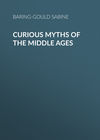Читать книгу: «Curious Myths of the Middle Ages»
The Wandering Jew
WHO, that has looked on Gustave Doré’s marvellous illustrations to this wild legend, can forget the impression they made upon his imagination?
I do not refer to the first illustration as striking, where the Jewish shoemaker is refusing to suffer the cross-laden Savior to rest a moment on his door-step, and is receiving with scornful lip the judgment to wander restless till the Second Coming of that same Redeemer. But I refer rather to the second, which represents the Jew, after the lapse of ages, bowed beneath the burden of the curse, worn with unrelieved toil, wearied with ceaseless travelling, trudging onward at the last lights of evening, when a rayless night of unabating rain is creeping on, along a sloppy path between dripping bushes; and suddenly he comes over against a wayside crucifix, on which the white glare of departing daylight falls, to throw it into ghastly relief against the pitch-black rain-clouds. For a moment we see the working of the miserable shoemaker’s mind. We feel that he is recalling the tragedy of the first Good Friday, and his head hangs heavier on his breast, as he recalls the part he had taken in that awful catastrophe.
Or, is that other illustration more remarkable, where the wanderer is amongst the Alps, at the brink of a hideous chasm; and seeing in the contorted pine-branches the ever-haunting scene of the Via Dolorosa, he is lured to cast himself into that black gulf in quest of rest, – when an angel flashes out of the gloom with the sword of flame turning every way, keeping him back from what would be to him a Paradise indeed, the repose of Death?
Or, that last scene, when the trumpet sounds and earth is shivering to its foundations, the fire is bubbling forth through the rents in its surface, and the dead are coming together flesh to flesh, and bone to bone, and muscle to muscle – then the weary man sits down and casts off his shoes! Strange sights are around him, he sees them not; strange sounds assail his ears, he hears but one – the trumpet-note which gives the signal for him to stay his wanderings and rest his weary feet.
I can linger over those noble woodcuts, and learn from them something new each time that I study them; they are picture-poems full of latent depths of thought. And now let us to the history of this most thrilling of all mediæval myths, if a myth.
If a myth, I say, for who can say for certain that it is not true? “Verily I say unto you, There be some standing here, which shall not taste of death till they see the Son of Man coming in His kingdom,”1 are our Lord’s words, which I can hardly think apply to the destruction of Jerusalem, as commentators explain it to escape the difficulty. That some should live to see Jerusalem destroyed was not very surprising, and hardly needed the emphatic Verily which Christ only used when speaking something of peculiarly solemn or mysterious import.
Besides, St. Luke’s account manifestly refers the coming in the kingdom to the Judgment, for the saying stands as follows: “Whosoever shall be ashamed of Me, and of My words, of him shall the Son of Man be ashamed, when He shall come in His own glory, and in His Father’s, and of the holy angels. But I tell you of a truth, there be some standing here, which shall not taste of death till they see the kingdom of God.”2
There can, I think, be no doubt in the mind of an unprejudiced person that the words of our Lord do imply that some one or more of those then living should not die till He came again. I do not mean to insist on the literal signification, but I plead that there is no improbability in our Lord’s words being fulfilled to the letter. That the circumstance is unrecorded in the Gospels is no evidence that it did not take place, for we are expressly told, “Many other signs truly did Jesus in the presence of His disciples, which are not written in this book;”3 and again, “There are also many other things which Jesus did, the which, if they should be written every one, I suppose that even the world itself could not contain the books that should be written.”4
We may remember also the mysterious witnesses who are to appear in the last eventful days of the world’s history and bear testimony to the Gospel truth before the antichristian world. One of these has been often conjectured to be St. John the Evangelist, of whom Christ said to Peter, “If I will that he tarry till I come, what is that to thee?”
The historical evidence on which the tale rests is, however, too slender for us to admit for it more than the barest claim to be more than myth. The names and the circumstances connected with the Jew and his doom vary in every account, and the only point upon which all coincide is, that such an individual exists in an undying condition, wandering over the face of the earth, seeking rest and finding none.
The earliest extant mention of the Wandering Jew is to be found in the book of the chronicles of the Abbey of St. Albans, which was copied and continued by Matthew Paris. He records that in the year 1228, “a certain Archbishop of Armenia the Greater came on a pilgrimage to England to see the relics of the saints, and visit the sacred places in the kingdom, as he had done in others; he also produced letters of recommendation from his Holiness the Pope, to the religious and the prelates of the churches, in which they were enjoined to receive and entertain him with due reverence and honor. On his arrival, he came to St. Albans, where he was received with all respect by the abbot and the monks; and at this place, being fatigued with his journey, he remained some days to rest himself and his followers, and a conversation took place between him and the inhabitants of the convent, by means of their interpreters, during which he made many inquiries relating to the religion and religious observances of this country, and told many strange things concerning the countries of the East. In the course of conversation he was asked whether he had ever seen or heard any thing of Joseph, a man of whom there was much talk in the world, who, when our Lord suffered, was present and spoke to Him, and who is still alive, in evidence of the Christian faith; in reply to which, a knight in his retinue, who was his interpreter, replied, speaking in French, ‘My lord well knows that man, and a little before he took his way to the western countries, the said Joseph ate at the table of my lord the Archbishop of Armenia, and he has often seen and conversed with him.’
“He was then asked about what had passed between Christ and the said Joseph; to which he replied, ‘At the time of the passion of Jesus Christ, He was seized by the Jews, and led into the hall of judgment before Pilate, the governor, that He might be judged by him on the accusation of the Jews; and Pilate, finding no fault for which he might sentence Him to death, said unto them, “Take Him and judge Him according to your law;” the shouts of the Jews, however, increasing, he, at their request, released unto them Barabbas, and delivered Jesus to them to be crucified. When, therefore, the Jews were dragging Jesus forth, and had reached the door, Cartaphilus, a porter of the hall in Pilate’s service, as Jesus was going out of the door, impiously struck Him on the back with his hand, and said in mockery, “Go quicker, Jesus, go quicker; why do you loiter?” and Jesus, looking back on him with a severe countenance, said to him, “I am going, and you shall wait till I return.” And according as our Lord said, this Cartaphilus is still awaiting His return. At the time of our Lord’s suffering he was thirty years old, and when he attains the age of a hundred years, he always returns to the same age as he was when our Lord suffered. After Christ’s death, when the Catholic faith gained ground, this Cartaphilus was baptized by Ananias (who also baptized the Apostle Paul), and was called Joseph. He dwells in one or other divisions of Armenia, and in divers Eastern countries, passing his time amongst the bishops and other prelates of the Church; he is a man of holy conversation, and religious; a man of few words, and very circumspect in his behavior; for he does not speak at all unless when questioned by the bishops and religious; and then he relates the events of olden times, and speaks of things which occurred at the suffering and resurrection of our Lord, and of the witnesses of the resurrection, namely, of those who rose with Christ, and went into the holy city, and appeared unto men. He also tells of the creed of the Apostles, and of their separation and preaching. And all this he relates without smiling, or levity of conversation, as one who is well practised in sorrow and the fear of God, always looking forward with dread to the coming of Jesus Christ, lest at the Last Judgment he should find him in anger whom, when on his way to death, he had provoked to just vengeance. Numbers came to him from different parts of the world, enjoying his society and conversation; and to them, if they are men of authority, he explains all doubts on the matters on which he is questioned. He refuses all gifts that are offered him, being content with slight food and clothing.’”
Much about the same date, Philip Mouskes, afterwards Bishop of Tournay, wrote his rhymed chronicle (1242), which contains a similar account of the Jew, derived from the same Armenian prelate: —
“Adonques vint un arceveskes
De çà mer, plains de bonnes tèques
Par samblant, et fut d’Armenie,”
and this man, having visited the shrine of “St. Tumas de Kantorbire,” and then having paid his devotions at “Monsigour St. Jake,” he went on to Cologne to see the heads of the three kings. The version told in the Netherlands much resembled that related at St. Albans, only that the Jew, seeing the people dragging Christ to his death, exclaims, —
“Atendés moi! g’i vois,
S’iert mis le faus profète en crois.”
Then
“Le vrais Dieux se regarda,
Et li a dit qu’e n’i tarda,
Icist ne t’atenderont pas,
Mais saces, tu m’atenderas.”
We hear no more of the wandering Jew till the sixteenth century, when we hear first of him in a casual manner, as assisting a weaver, Kokot, at the royal palace in Bohemia (1505), to find a treasure which had been secreted by the great-grandfather of Kokot, sixty years before, at which time the Jew was present. He then had the appearance of being a man of seventy years.5
Curiously enough, we next hear of him in the East, where he is confounded with the prophet Elijah. Early in the century he appeared to Fadhilah, under peculiar circumstances.
After the Arabs had captured the city of Elvan, Fadhilah, at the head of three hundred horsemen, pitched his tents, late in the evening, between two mountains. Fadhilah, having begun his evening prayer with a loud voice, heard the words “Allah akbar” (God is great) repeated distinctly, and each word of his prayer was followed in a similar manner. Fadhilah, not believing this to be the result of an echo, was much astonished, and cried out, “O thou! whether thou art of the angel ranks, or whether thou art of some other order of spirits, it is well; the power of God be with thee; but if thou art a man, then let mine eyes light upon thee, that I may rejoice in thy presence and society.” Scarcely had he spoken these words, before an aged man, with bald head, stood before him, holding a staff in his hand, and much resembling a dervish in appearance. After having courteously saluted him, Fadhilah asked the old man who he was. Thereupon the stranger answered, “Bassi Hadhret Issa, I am here by command of the Lord Jesus, who has left me in this world, that I may live therein until he comes a second time to earth. I wait for this Lord, who is the Fountain of Happiness, and in obedience to his command I dwell behind yon mountain.” When Fadhilah heard these words, he asked when the Lord Jesus would appear; and the old man replied that his appearing would be at the end of the world, at the Last Judgment. But this only increased Fadhilah’s curiosity, so that he inquired the signs of the approach of the end of all things, whereupon Zerib Bar Elia gave him an account of general, social, and moral dissolution, which would be the climax of this world’s history.6
In 1547 he was seen in Europe, if we are to believe the following narration: —
“Paul von Eitzen, doctor of the Holy Scriptures, and Bishop of Schleswig,7 related as true for some years past, that when he was young, having studied at Wittemberg, he returned home to his parents in Hamburg in the winter of the year 1547, and that on the following Sunday, in church, he observed a tall man, with his hair hanging over his shoulders, standing barefoot, during the sermon, over against the pulpit, listening with deepest attention to the discourse, and, whenever the name of Jesus was mentioned, bowing himself profoundly and humbly, with sighs and beating of the breast. He had no other clothing, in the bitter cold of the winter, except a pair of hose which were in tatters about his feet, and a coat with a girdle which reached to his feet; and his general appearance was that of a man of fifty years. And many people, some of high degree and title, have seen this same man in England, France, Italy, Hungary, Persia, Spain, Poland, Moscow, Lapland, Sweden, Denmark, Scotland, and other places.
“Every one wondered over the man. Now, after the sermon, the said Doctor inquired diligently where the stranger was to be found; and when he had sought him out, he inquired of him privately whence he came, and how long that winter he had been in the place. Thereupon he replied, modestly, that he was a Jew by birth, a native of Jerusalem, by name Ahasverus, by trade a shoemaker; he had been present at the crucifixion of Christ, and had lived ever since, travelling through various lands and cities, the which he substantiated by accounts he gave; he related also the circumstances of Christ’s transference from Pilate to Herod, and the final crucifixion, together with other details not recorded in the Evangelists and historians; he gave accounts of the changes of government in many countries, especially of the East, through several centuries; and moreover he detailed the labors and deaths of the holy Apostles of Christ most circumstantially.
“Now when Doctor Paul v. Eitzen heard this with profound astonishment, on account of its incredible novelty, he inquired further, in order that he might obtain more accurate information. Then the man answered, that he had lived in Jerusalem at the time of the crucifixion of Christ, whom he had regarded as a deceiver of the people, and a heretic; he had seen Him with his own eyes, and had done his best, along with others, to bring this deceiver, as he regarded Him, to justice, and to have Him put out of the way. When the sentence had been pronounced by Pilate, Christ was about to be dragged past his house; then he ran home, and called together his household to have a look at Christ, and see what sort of a person He was.
“This having been done, he had his little child on his arm, and was standing in his doorway, to have a sight of the Lord Jesus Christ.
“As, then, Christ was led by, bowed under the weight of the heavy cross, He tried to rest a little, and stood still a moment; but the shoemaker, in zeal and rage, and for the sake of obtaining credit among the other Jews, drove the Lord Christ forward, and told Him to hasten on His way. Jesus, obeying, looked at him, and said, ‘I shall stand and rest, but thou shalt go till the last day.’ At these words the man set down the child; and, unable to remain where he was, he followed Christ, and saw how cruelly He was crucified, how He suffered, how He died. As soon as this had taken place, it came upon him suddenly that he could no more return to Jerusalem, nor see again his wife and child, but must go forth into foreign lands, one after another, like a mournful pilgrim. Now, when, years after, he returned to Jerusalem, he found it ruined and utterly razed, so that not one stone was left standing on another; and he could not recognize former localities.
“He believes that it is God’s purpose, in thus driving him about in miserable life, and preserving him undying, to present him before the Jews at the end, as a living token, so that the godless and unbelieving may remember the death of Christ, and be turned to repentance. For his part he would well rejoice were God in heaven to release him from this vale of tears. After this conversation, Doctor Paul v. Eitzen, along with the rector of the school of Hamburg, who was well read in history, and a traveller, questioned him about events which had taken place in the East since the death of Christ, and he was able to give them much information on many ancient matters; so that it was impossible not to be convinced of the truth of his story, and to see that what seems impossible with men is, after all, possible with God.
“Since the Jew has had his life extended, he has become silent and reserved, and only answers direct questions. When invited to become any one’s guest, he eats little, and drinks in great moderation; then hurries on, never remaining long in one place. When at Hamburg, Dantzig, and elsewhere, money has been offered him, he never took more than two skillings (fourpence, one farthing), and at once distributed it to the poor, as token that he needed no money, for God would provide for him, as he rued the sins he had committed in ignorance.
“During the period of his stay in Hamburg and Dantzig he was never seen to laugh. In whatever land he travelled he spoke its language, and when he spoke Saxon, it was like a native Saxon. Many people came from different places to Hamburg and Dantzig in order to see and hear this man, and were convinced that the providence of God was exercised in this individual in a very remarkable manner. He gladly listened to God’s word, or heard it spoken of always with great gravity and compunction, and he ever reverenced with sighs the pronunciation of the name of God, or of Jesus Christ, and could not endure to hear curses; but whenever he heard any one swear by God’s death or pains, he waxed indignant, and exclaimed, with vehemence and with sighs, ‘Wretched man and miserable creature, thus to misuse the name of thy Lord and God, and His bitter sufferings and passion. Hadst thou seen, as I have, how heavy and bitter were the pangs and wounds of thy Lord, endured for thee and for me, thou wouldst rather undergo great pain thyself than thus take His sacred name in vain!’
“Such is the account given to me by Doctor Paul von Eitzen, with many circumstantial proofs, and corroborated by certain of my own old acquaintances who saw this same individual with their own eyes in Hamburg.
“In the year 1575 the Secretary Christopher Krause, and Master Jacob von Holstein, legates to the Court of Spain, and afterwards sent into the Netherlands to pay the soldiers serving his Majesty in that country, related on their return home to Schleswig, and confirmed with solemn oaths, that they had come across the same mysterious individual at Madrid in Spain, in appearance, manner of life, habits, clothing, just the same as he had appeared in Hamburg. They said that they had spoken with him, and that many people of all classes had conversed with him, and found him to speak good Spanish. In the year 1599, in December, a reliable person wrote from Brunswick to Strasburg that the same mentioned strange person had been seen alive at Vienna in Austria, and that he had started for Poland and Dantzig; and that he purposed going on to Moscow. This Ahasverus was at Lubeck in 1601, also about the same date in Revel in Livonia, and in Cracow in Poland. In Moscow he was seen of many and spoken to by many.
“What thoughtful, God-fearing persons are to think of the said person, is at their option. God’s works are wondrous and past finding out, and are manifested day by day, only to be revealed in full at the last great day of account.
“Dated, Revel, August 1st, 1613.“D. W.“D.“Chrysostomus Dudulœus,“Westphalus.”
The statement that the Wandering Jew appeared in Lubeck in 1601, does not tally with the more precise chronicle of Henricus Bangert, which gives: “Die 14 Januarii Anno MDCIII., adnotatum reliquit Lubecæ fuisse Judæum illum immortalem, qui se Christi crucifixioni interfuisse affirmavit.”8
In 1604 he seems to have appeared in Paris. Rudolph Botoreus says, under this date, “I fear lest I be accused of giving ear to old wives’ fables, if I insert in these pages what is reported all over Europe of the Jew, coeval with the Savior Christ; however, nothing is more common, and our popular histories have not scrupled to assert it. Following the lead of those who wrote our annals, I may say that he who appeared not in one century only, in Spain, Italy, and Germany, was also in this year seen and recognized as the same individual who had appeared in Hamburg, anno MDLXVI. The common people, bold in spreading reports, relate many things of him; and this I allude to, lest anything should be left unsaid.”9
J. C. Bulenger puts the date of the Hamburg visit earlier. “It was reported at this time that a Jew of the time of Christ was wandering without food and drink, having for a thousand and odd years been a vagabond and outcast, condemned by God to rove, because he, of that generation of vipers, was the first to cry out for the crucifixion of Christ and the release of Barabbas; and also because soon after, when Christ, panting under the burden of the rood, sought to rest before his workshop (he was a cobbler), the fellow ordered Him off with acerbity. Thereupon Christ replied, ‘Because thou grudgest Me such a moment of rest, I shall enter into My rest, but thou shalt wander restless.’ At once, frantic and agitated, he fled through the whole earth, and on the same account to this day he journeys through the world. It was this person who was seen in Hamburg in MDLXIV. Credat Judæus Apella! I did not see him, or hear anything authentic concerning him, at that time when I was in Paris.”10
A curious little book,11 written against the quackery of Paracelsus, by Leonard Doldius, a Nürnberg physician, and translated into Latin and augmented, by Andreas Libavius, doctor and physician of Rotenburg, alludes to the same story, and gives the Jew a new name nowhere else met with. After having referred to a report that Paracelsus was not dead, but was seated alive, asleep or napping, in his sepulchre at Strasburg, preserved from death by some of his specifics, Libavius declares that he would sooner believe in the old man, the Jew, Ahasverus, wandering over the world, called by some Buttadæus, and otherwise, again, by others.
He is said to have appeared in Naumburg, but the date is not given; he was noticed in church, listening to the sermon. After the service he was questioned, and he related his story. On this occasion he received presents from the burgers.12 In 1633 he was again in Hamburg.13 In the year 1640, two citizens, living in the Gerberstrasse, in Brussels, were walking in the Sonian wood, when they encountered an aged man, whose clothes were in tatters and of an antiquated appearance. They invited him to go with them to a house of refreshment, and he went with them, but would not seat himself, remaining on foot to drink. When he came before the doors with the two burgers, he told them a great deal; but they were mostly stories of events which had happened many hundred years before. Hence the burgers gathered that their companion was Isaac Laquedem, the Jew who had refused to permit our Blessed Lord to rest for a moment at his door-step, and they left him full of terror. In 1642 he is reported to have visited Leipzig. On the 22d July, 1721, he appeared at the gates of the city of Munich.14 About the end of the seventeenth century or the beginning of the eighteenth, an impostor, calling himself the Wandering Jew, attracted attention in England, and was listened to by the ignorant, and despised by the educated. He, however, managed to thrust himself into the notice of the nobility, who, half in jest, half in curiosity, questioned him, and paid him as they might a juggler. He declared that he had been an officer of the Sanhedrim, and that he had struck Christ as he left the judgment hall of Pilate. He remembered all the Apostles, and described their personal appearance, their clothes, and their peculiarities. He spoke many languages, claimed the power of healing the sick, and asserted that he had travelled nearly all over the world. Those who heard him were perplexed by his familiarity with foreign tongues and places. Oxford and Cambridge sent professors to question him, and to discover the imposition, if any. An English nobleman conversed with him in Arabic. The mysterious stranger told his questioner in that language that historical works were not to be relied upon. And on being asked his opinion of Mahomet, he replied that he had been acquainted with the father of the prophet, and that he dwelt at Ormuz. As for Mahomet, he believed him to have been a man of intelligence; once when he heard the prophet deny that Christ was crucified, he answered abruptly by telling him he was a witness to the truth of that event. He related also that he was in Rome when Nero set it on fire; he had known Saladin, Tamerlane, Bajazeth, Eterlane, and could give minute details of the history of the Crusades.15
Whether this wandering Jew was found out in London or not, we cannot tell, but he shortly after appeared in Denmark, thence travelled into Sweden, and vanished.
Such are the principal notices of the Wandering Jew which have appeared. It will be seen at once how wanting they are in all substantial evidence which could make us regard the story in any other light than myth.
But no myth is wholly without foundation, and there must be some substantial verity upon which this vast superstructure of legend has been raised. What that is I am unable to discover.
It has been suggested by some that the Jew Ahasverus is an impersonation of that race which wanders, Cain-like, over the earth with the brand of a brother’s blood upon it, and one which is not to pass away till all be fulfilled, not to be reconciled to its angered God till the times of the Gentiles are accomplished. And yet, probable as this supposition may seem at first sight, it is not to be harmonized with some of the leading features of the story. The shoemaker becomes a penitent, and earnest Christian, whilst the Jewish nation has still the veil upon its heart; the wretched wanderer eschews money, and the avarice of the Israelite is proverbial.
According to local legend, he is identified with the Gypsies, or rather that strange people are supposed to be living under a curse somewhat similar to that inflicted on Ahasverus, because they refused shelter to the Virgin and Child on their flight into Egypt.16 Another tradition connects the Jew with the wild huntsman, and there is a forest at Bretten, in Swabia, which he is said to haunt. Popular superstition attributes to him there a purse containing a groschen, which, as often as it is expended, returns to the spender.17
In the Harz one form of the Wild Huntsman myth is to this effect: that he was a Jew who had refused to suffer our Blessed Lord to drink out of a river, or out of a horse-trough, but had contemptuously pointed out to Him the hoof-print of a horse, in which a little water had collected, and had bid Him quench His thirst thence.18
As the Wild Huntsman is the personification of the storm, it is curious to find in parts of France that the sudden roar of a gale at night is attributed by the vulgar to the passing of the Everlasting Jew.
A Swiss story is, that he was seen one day standing upon the Matterberg, which is below the Matterhorn, contemplating the scene with mingled sorrow and wonder. Once before he stood on that spot, and then it was the site of a flourishing city; now it is covered with gentian and wild pinks. Once again will he revisit the hill, and that will be on the eve of Judgment.
Perhaps, of all the myths which originated in the middle ages, none is more striking than that we have been considering; indeed, there is something so calculated to arrest the attention and to excite the imagination in the outline of the story, that it is remarkable that we should find an interval of three centuries elapse between its first introduction into Europe by Matthew Paris and Philip Mouskes, and its general acceptance in the sixteenth century. As a myth, its roots lie in that great mystery of human life which is an enigma never solved, and ever originating speculation.
What was life? Was it of necessity limited to fourscore years, or could it be extended indefinitely? were questions curious minds never wearied of asking. And so the mythology of the past teemed with legends of favored or accursed mortals, who had reached beyond the term of days set to most men. Some had discovered the water of life, the fountain of perpetual youth, and were ever renewing their strength. Others had dared the power of God, and were therefore sentenced to feel the weight of His displeasure, without tasting the repose of death.
John the Divine slept at Ephesus, untouched by corruption, with the ground heaving over his breast as he breathed, waiting the summons to come forth and witness against Antichrist. The seven sleepers reposed in a cave, and centuries glided by like a watch in the night. The monk of Hildesheim, doubting how with God a thousand years could be as yesterday, listened to the melody of a bird in the green wood during three minutes, and found that in three minutes three hundred years had flown. Joseph of Arimathæa, in the blessed city of Sarras, draws perpetual life from the Saint Graal; Merlin sleeps and sighs in an old tree, spell-bound of Vivien. Charlemagne and Barbarossa wait, crowned and armed, in the heart of the mountain, till the time comes for the release of Fatherland from despotism. And, on the other hand, the curse of a deathless life has passed on the Wild Huntsman, because he desired to chase the red-deer for evermore; on the Captain of the Phantom Ship, because he vowed he would double the Cape whether God willed it or not; on the Man in the Moon, because he gathered sticks during the Sabbath rest; on the dancers of Kolbeck, because they desired to spend eternity in their mad gambols.





















